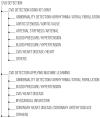A Systematic Review of Machine Learning and IoT Applied to the Prediction and Monitoring of Cardiovascular Diseases
- PMID: 37628438
- PMCID: PMC10454027
- DOI: 10.3390/healthcare11162240
A Systematic Review of Machine Learning and IoT Applied to the Prediction and Monitoring of Cardiovascular Diseases
Abstract
According to the Pan American Health Organization, cardiovascular disease is the leading cause of death worldwide, claiming an estimated 17.9 million lives each year. This paper presents a systematic review to highlight the use of IoT, IoMT, and machine learning to detect, predict, or monitor cardiovascular disease. We had a final sample of 164 high-impact journal papers, focusing on two categories: cardiovascular disease detection using IoT/IoMT technologies and cardiovascular disease using machine learning techniques. For the first category, we found 82 proposals, while for the second, we found 85 proposals. The research highlights list of IoT/IoMT technologies, machine learning techniques, datasets, and the most discussed cardiovascular diseases. Neural networks have been popularly used, achieving an accuracy of over 90%, followed by random forest, XGBoost, k-NN, and SVM. Based on the results, we conclude that IoT/IoMT technologies can predict cardiovascular diseases in real time, ensemble techniques obtained one of the best performances in the accuracy metric, and hypertension and arrhythmia were the most discussed diseases. Finally, we identified the lack of public data as one of the main obstacles for machine learning approaches for cardiovascular disease prediction.
Keywords: IoMT; IoT; cardiovascular disease; machine learning; systematic review; wearable technologies.
Conflict of interest statement
The authors declare no conflicts of interest.
Figures










References
-
- Pan American Health Organization [(accessed on 12 March 2022)]. Available online: https://www.paho.org/en/topics/cardiovascular-diseases.
-
- Secretaría de Salud, Enfermedades no Transmisibles. [(accessed on 12 March 2022)]. Available online: https://www.gob.mx/cms/uploads/attachment/file/416454/Enfermedades_No_Tr....
-
- World Health Organization [(accessed on 12 March 2022)]. Available online: https://www.who.int/health-topics/cardiovascular-diseases/#tab=tab_1.
-
- Pizarro J. Internet de las Cosas (IoT) con Esp. Manual Práctico. 1st ed. Ediciones Paraninfo; Madrid, Spain: 2020. p. 1.
Publication types
LinkOut - more resources
Full Text Sources

